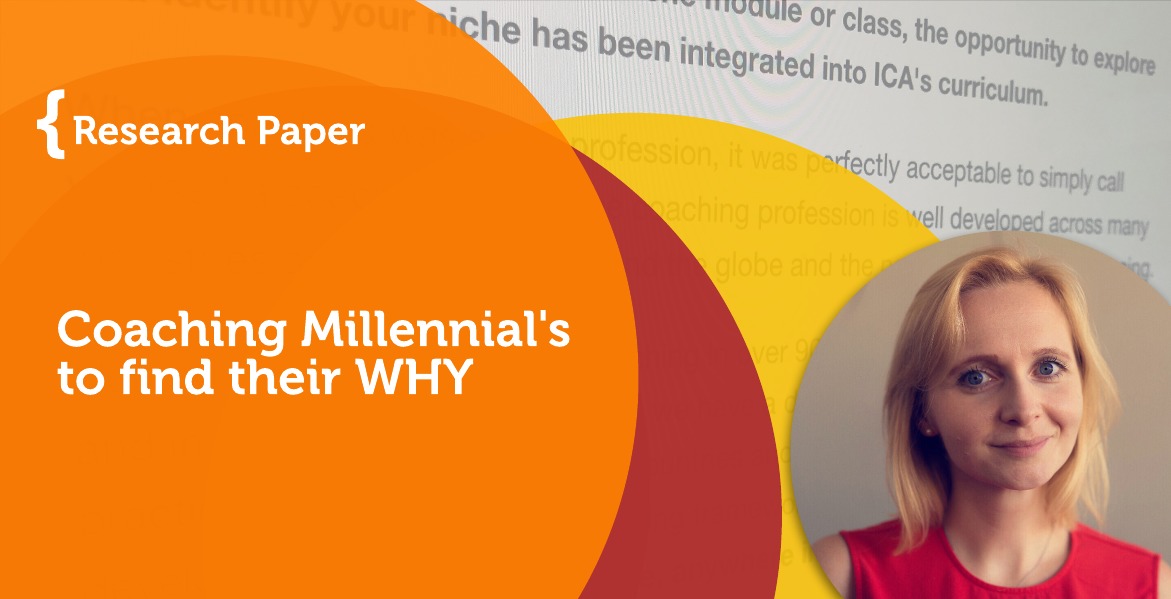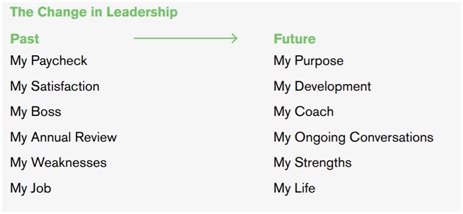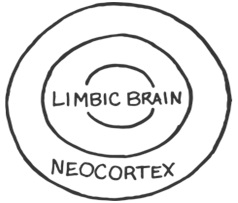
Research Paper By Dijana Kokai
(Career Coach, SWITZERLAND)
Introduction
Despite the countless reports that have been written about how challenging Millennials’ behavior is in the workplace and what negative financial impact it has. The focus of this research paper is on the Millennial itself. The discrepancy between putting the job first and at the same time being disengaged and constantly looking for the next job opportunity is worth looking into(Gallup, 2016). How can coaching support the Millennial on its journey?
Characteristics of Millennials
Millennials are born between 1980 and 1996 and currently makeup 38% of the US workforce. It is likely that this number will increase in the coming years since some of the late Millennials have not joined the workforce yet(Gallup, 2016).
Millennials put their work as a priority. They focus less on getting engaged and buy houses. Their main goal is to have a job where they seek fulfillment and well-being. At the same time, they have the highest level of not being engaged at work with 55%, compared to all the other generations in the workforce. They are known as job-hoppers and 6 out of 10 Millennials considering changing their job soon(Gallup, 2016).
Good to know when coaching Millennials:
How Millennials seethe workplace
Below the change in expectations that Millennials have compared to previous generations. Instead of a paycheck, they are looking for purpose. Their development is important to them and they see their work not as a job but as their life. Expecting to find all of the below listed in a job or an employer, can lead to a constant search for the next better fit.
 Figure 1: Gallup, 206, Change in Leadership, page 15
Figure 1: Gallup, 206, Change in Leadership, page 15
The process to discover the Millennials WHY
Your wellbeing comes from within
As Michel Neil stated:
Wellbeing is not the fruit of something you do, it’s the essence of who you are. (Neill, 2018)
Applying Neil’s quote to the Millennial’s circumstances, imply that no external actions are going to lead to long-lasting well-being. Because the definition of well-being in the Millennials world is attached to goals and actions. Every goal is continuously evolving into another and more actions are required. Thus, as long as the sense of fulfillment and purpose is searched outside of oneself, it will never be a part of yourself(Neill, 2018).
Conditioned Millennials believe that success, fulfillment, and purpose is found at a job and that their employer is responsible for providing all those emotional aspects of life for them(Gallup, 2016). The learning here is, that the responsibility lies with the Millennial itself. Those aspirations in life are very personal and can only be answered individually and from within (Robbins, 2018).
Your own WHY drives you
Simon Sinek’s concept of ‘The Golden Circle’, is a method to illustrate what drives organizations and individuals. When used in communication with others, the full picture of the intentional drivers and true motivation can be shown(Sinek, Start which Why, 2009).
The Gallup report state that it is crucial for Millennials to know and understand the organization’s purpose and how this is translated into their daily work.
 Figure 2: Sinek, 2009, The Golden Circle, page 38
Figure 2: Sinek, 2009, The Golden Circle, page 38
Thus, if the question about personal and organizational purpose is so vital, why it is difficult to articulate a sense-making answer? In order to find an answer to this, a look into the human brain is required. The image below is using ‘The Golden Circle’ model and indicates which questions are answered in which part of our brain (Sinek, Start which Why, 2009).
 Figure 3: Sinek, 2009, The Golden Circle, page 57
Figure 3: Sinek, 2009, The Golden Circle, page 57
The what question, which is the outer circle is answered in the Neocortex. This is the newest part of the human brain. It is responsible for all rational and analytical thoughts. It supports the understanding of facts and figures as well as language.
The how and why the question is answered in the limbic brain. This part of the brain controls behavior and decision making. It is also responsible for the wide range of feelings that humans are capable of. Arguments that target how and why questions are more personal, circumvent the fact and figures part of the human brain, and reach a person’s emotions directly. This way of communicating is more effective, touching, and long-lasting(Sinek, Start which Why, 2009).
The limbic brain does not have the capability for language. Meaning, all the feelings that are generated in the limbic brain, cannot be put in words. Therefore, phrases like ‘it is a gut feeling’ or ‘it just feels right’ are common. The Neocortex which is capable of language but at the same time responsible for hard facts is struggling to articulate correctly the feelings coming from the limbic brain. Therefore, it is challenging at times to put feelings into language and express why e.g. a choice is made, despite the hard facts not being in favor of the decision(Sinek, Start which Why, 2009).
What does that mean for the Millennials? The why question relates to the true sense of purpose, it is within every human. This purpose is a driving source of everything humans do. Due to the human brain structure, it is challenging to put why into words. But it is there. The right question is; how to find it?
Discover your WHY
Simon Sinek’s methodology to ‘find your why’ has been applied to organizations and individuals equally. It is a process similar to a coaching session where the why-seeker is in charge and shares its story. The Millennial’s why is rooted in its experience, learnings, and the moments that shaped them who they are today. Knowing that there why is already within the Millennial itself should stop the outside seeking process(Sinek, Find Your Why, 2017).
During this process the Millennials and the coach have different roles:
Role of the Millennial
Role of the coach
- What about this story that makes it special to you?
- What lesson from that experience are you still carrying with you?
- What do you admire and respect that person? (Sinek, Find Your Why, 2017)
The process of uncovering your why
Applying the why finding process of Sinek to a Millennial includes the following steps:
 Figure 4: Sinek, 2009, Find your Why, page 75
Figure 4: Sinek, 2009, Find your Why, page 75
Formulate your WHY Statement
The WHY statement helps to put why into a comprehensive sentence. It should feel right, be authentic and resonate very well with the Millennial. The focus is on ‘contribution’ and ‘impact’(Sinek, Find Your Why, 2017). The contribution is one of the highest basic human needs and means giving beyond yourself. Serving others and contributing to someone or something else, is meeting the human spiritual needs(Robbins, 2018). (Hiemstra, 2001)
The WHY statement has the following structure:
To ______(contribution)_______ SO THAT _______(impact)_________
Here Simon Sinek’s statement:
To inspire people to do the things that inspire them so that, together, we can change our world (Sinek, Find Your Why, 2017)
It is important to mention, that the WHY statement is something that is already there and is part of their past stories. Nothing that they would like to do in the future, rather than what they have already done in the past. The goal is to find a personal definition of contribution and impact. Even if the first version of the sentence does not sound perfect, it should feel right. It can be reformulated over time until it represents fully for what the Millennial stands for(Sinek, Find Your Why, 2017).
Taking the time and let the Millennial explore the feelings they have while going through the WHY process and what does their personal why mean to them. A journaling exercise is recommended for the coachee afterward, to reflect on the experience, strengthen the insights, and keep not on their personal thoughts (Hiemstra, 2001).
Apply your WHY
Now that the Millennial knows what themes they relate most to and have formulated their personal Why statement, it is time to explore how to put it into practice.
In case the Millennial is employed, the question if their own why is represented in the company they are working for. Is there an employer actively sharing and living the organizational why? If not, what can the Millennial do? The coach supports their coachee to further explore how they can actively live their way on a daily basis.
It is important to note, that the Millennial’s why and they actively living their why is their own responsibility. Forcing the external world to adjust to the Millennial’s why is not the way to go forward. What can the Millennials do out of their own space?
In case they do not have an employer that is sharing their personal why what are other options to life theirs why. Encourage the Millennials to think outside of their own conditioning. Explore options and focus on what feels right. The coach should provide support and encouragement to expand their thinking and the options that are currently visible and invisible for the Millennials(ICA, 2019). The goal is that after having found their own purpose, they continue to go forward and implementing it in their life.
Conclusion
The Millennials seeking purpose and well-being can be achieved if the right concepts are applied. Most importantly, everything is already within the individual. There so external seeking going to bring the desired result. The willingness to look inwards, reflect on its own stories, and find it’s true why is a process that requires support. Coaching can facilitate this development and support the coachee on its journey. If living by its true purpose is the why-seeking process is only the beginning of the journey.
List of Figures
Figure 1: Gallup, 2016, Change in Leadership, page 15. 4
Figure 2: Sinek, 2009, The Golden Circle, page 38. 5
Figure 3: Sinek, 2009, The Golden Circle, page 57. 6
Figure 4: Sinek, 2009, The Golden Circle, page 75. 8
Bibliography
Gallup, I. (2016). How Millennials Want. Washington: Gallup, Inc. Retrieved from https://www.gallup.com/workplace/238073/millennials-work-live.aspx
Hiemstra, R. (2001). Promoting journal writing in adult education. In R. Hiemstra, New Directions for Adult and Continuing Education (pp. 19 -26). San Francisco: Jossey-Bass.
ICA. (2019, 12 29). International Coach Academy. Retrieved from
KPMG. (2017). Meet the Millennials. KPMG. Retrieved from https://home.kpmg/content/dam/kpmg/uk/pdf/2017/04/Meet-the-Millennials-Secured.pdf
Neill, M. (2018). Supercoach. London: Hay House UK Ltd.
Robbins, T. (2018). Unleash the Power Within. Robbins Research International, Inc.
Sinek, S. (2009). Start which Why. United States: Penguin Group (USA) Inc.
Sinek, S. (2017). Find Your Why. United States: Penguin Random House.